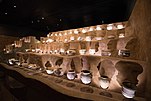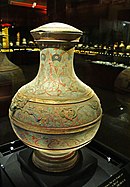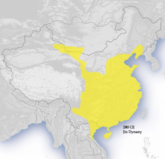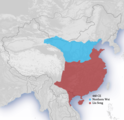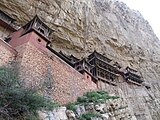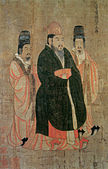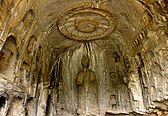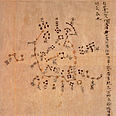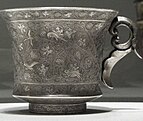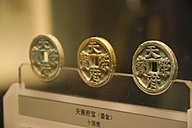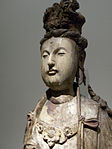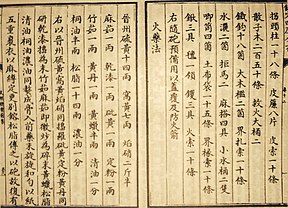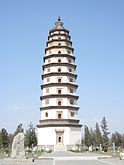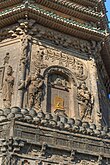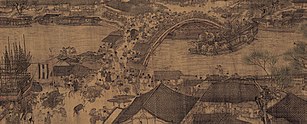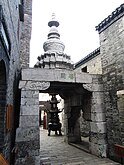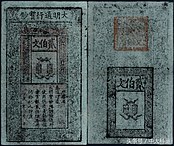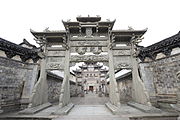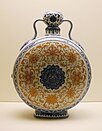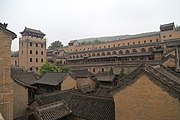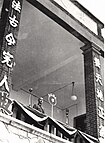История Китая
| Часть серии на |
| История Китая |
|---|
The history of China spans several millennia across a wide geographical area. Each region now considered part of the Chinese world has experienced periods of unity, fracture, prosperity, and strife. Chinese civilization first emerged in the Yellow River valley, which along with the Yangtze basin constitutes the geographic core of the Chinese cultural sphere. China maintains a rich diversity of ethnic and linguistic people groups. The traditional lens for viewing Chinese history is the dynastic cycle: imperial dynasties rise and fall, and are ascribed certain achievements. Throughout pervades the narrative that Chinese civilization can be traced as an unbroken thread many thousands of years into the past, making it one of the cradles of civilization. At various times, states representative of a dominant Chinese culture have directly controlled areas stretching as far west as the Tian Shan, the Tarim Basin, and the Himalayas, as far north as the Sayan Mountains, and as far south as the delta of the Red River.
The Neolithic period saw increasingly complex polities begin to emerge along the Yellow and Yangtze rivers. The Erlitou culture in the central plains of China is sometimes identified with the Xia dynasty (3rd millennium BC) of traditional Chinese historiography. The earliest surviving written Chinese dates to roughly 1250 BC, consisting of divinations inscribed on oracle bones. Chinese bronze inscriptions, ritual texts dedicated to ancestors, form another large corpus of early Chinese writing. The earliest strata of received literature in Chinese include poetry, divination, and records of official speeches. China is believed to be one of a very few loci of independent invention of writing, and the earliest surviving records display an already-mature written language. The culture remembered by the earliest extant literature is that of the Zhou dynasty (c. 1046 – 256 BC), China's Axial Age, during which the Mandate of Heaven was introduced, and foundations laid for philosophies such as Confucianism, Taoism, Legalism, and Wuxing.
China was first united under a single imperial state by Qin Shi Huang in 221 BC. Orthography, weights, measures, and law were all standardized. Shortly thereafter, China entered its classical era with the Han dynasty (202 BC – 220 AD), marking a critical period. A term for the Chinese language is still "Han language", and the dominant Chinese ethnic group is known as Han Chinese. The Chinese empire reached some of its farthest geographical extents during this period. Confucianism was officially sanctioned and its core texts were edited into their received forms. Wealthy landholding families independent of the ancient aristocracy began to wield significant power. Han technology can be considered on par with that of the contemporaneous Roman Empire: mass production of paper aided the proliferation of written documents, and the written language of this period was employed for millennia afterwards. China became known internationally for its sericulture. When the Han imperial order finally collapsed after four centuries, China entered an equally lengthy period of disunity, during which Buddhism began to have a significant impact on Chinese culture, while Calligraphy, art, historiography, and storytelling flourished. Wealthy families in some cases became more powerful than the central government. The Yangtze River valley was incorporated into the dominant cultural sphere.
A period of unity began in 581 with the Sui dynasty, which soon gave way to the long-lived Tang dynasty (608–907), regarded as another Chinese golden age. The Tang dynasty saw flourishing developments in science, technology, poetry, economics, and geographical influence. China's only officially recognized empress, Wu Zetian, reigned during the dynasty's first century. Buddhism was adopted by Tang emperors. "Tang people" is the other common demonym for the Han ethnic group. After the Tang fractured, the Song dynasty (960–1279) saw the maximal extent of imperial Chinese cosmopolitan development. Mechanical printing was introduced, and many of the earliest surviving witnesses of certain texts are wood-block prints from this era. Song scientific advancement led the world, and the imperial examination system gave ideological structure to the political bureaucracy. Confucianism and Taoism were fully knit together in Neo-Confucianism.
Eventually, the Mongol Empire conquered all of China, establishing the Yuan dynasty in 1271. Contact with Europe began to increase during this time. Achievements under the subsequent Ming dynasty (1368–1644) include global exploration, fine porcelain, and many extant public works projects, such as those restoring the Grand Canal and Great Wall. Three of the four Classic Chinese Novels were written during the Ming. The Qing dynasty that succeeded the Ming was ruled by ethnic Manchu people. The Qianlong emperor (r. 1735–1796) commissioned a complete encyclopaedia of imperial libraries, totaling nearly a billion words. Imperial China reached its greatest territorial extent of during the Qing, but China came into increasing conflict with European powers, culminating in the Opium Wars and subsequent unequal treaties.
The 1911 Xinhai Revolution, led by Sun Yat-sen and others, created the modern Republic of China. From 1927 to 1949, a costly civil war roiled between the Republican government under Chiang Kai-shek and the Communist-aligned Chinese Red Army, interrupted by the industrialized Empire of Japan invading the divided country until its defeat in the Second World War.
After the Communist victory, Mao Zedong proclaimed the establishment of the People's Republic of China (PRC) in 1949, with the Republic retreating to Taiwan. Both governments still claim sole legitimacy of the entire mainland area. The PRC has slowly accumulated the majority of diplomatic recognition, and Taiwan's status remains disputed to this day. From 1966 to 1976, the Cultural Revolution in mainland China helped consolidate Mao's power towards the end of his life. After his death, the government began economic reforms under Deng Xiaoping, and became the world's fastest-growing major economy.[when?] China had been the most populous nation in the world for decades since its unification, until it was surpassed by India in 2023.
Prehistory
Paleolithic (1.7 Ma – 12 ka)
The archaic human species of Homo erectus arrived in Eurasia sometime between 1.3 and 1.8 million years ago (Ma) and numerous remains of its subspecies have been found in what is now China.[1] The oldest of these is the southwestern Yuanmou Man (元谋人; in Yunnan), dated to c. 1.7 Ma, which lived in a mixed bushland-forest environment alongside chalicotheres, deer, the elephant Stegodon, rhinos, cattle, pigs, and the giant short-faced hyena.[2] The better-known Peking Man (北京猿人; near Beijing) of 700,000–400,000 BP,[1] was discovered in the Zhoukoudian cave alongside scrapers, choppers, and, dated slightly later, points, burins, and awls.[3] Other Homo erectus fossils have been found widely throughout the region, including the northwestern Lantian Man in Shaanxi, as well minor specimens in northeastern Liaoning and southern Guangdong.[1] The dates of most Paleolithic sites were long debated but have been more reliably established based on modern magnetostratigraphy: Majuangou at 1.66–1.55 Ma, Lanpo at 1.6 Ma, Xiaochangliang at 1.36 Ma, Xiantai at 1.36 Ma, Banshan at 1.32 Ma, Feiliang at 1.2 Ma and Donggutuo at 1.1 Ma.[4] Evidence of fire use by Homo erectus occurred between 1–1.8 million years BP at the archaeological site of Xihoudu, Shanxi Province.[5]
The circumstances surrounding the evolution of Homo erectus to contemporary H. sapiens is debated; the three main theories include the dominant "Out of Africa" theory (OOA), the regional continuity model and the admixture variant of the OOA hypothesis.[1] Regardless, the earliest modern humans have been dated to China at 120,000–80,000 BP based on fossilized teeth discovered in Fuyan Cave of Dao County, Hunan.[6] The larger animals which lived alongside these humans include the extinct Ailuropoda baconi panda, the Crocuta ultima hyena, the Stegodon, and the giant tapir.[6] Evidence of Middle Palaeolithic Levallois technology has been found in the lithic assemblage of Guanyindong Cave site in southwest China, dated to approximately 170,000–80,000 years ago.[7]
Neolithic
The Neolithic Age in China is considered to have begun about 10,000 years ago.[8] Because the Neolithic is conventionally defined by the presence of agriculture, it follows that the Neolithic began at different times in the various regions of what is now China. Agriculture in China developed gradually, with initial domestication of a few grains and animals gradually expanding with the addition of many others over subsequent millennia.[9] The earliest evidence of cultivated rice, found by the Yangtze River, was carbon-dated to 8,000 years ago.[10] Early evidence for millet agriculture in the Yellow River valley was radiocarbon-dated to about 7000 BC.[11] The Jiahu site is one of the best preserved early agricultural villages (7000 to 5800 BC). At Damaidi in Ningxia, 3,172 cliff carvings dating to 6000–5000 BC have been discovered, "featuring 8,453 individual characters such as the sun, moon, stars, gods and scenes of hunting or grazing", according to researcher Li Xiangshi. Written symbols, sometimes called proto-writing, were found at the site of Jiahu, which is dated around 7000 BC,[12] Damaidi around 6000 BC, Dadiwan from 5800 BC to 5400 BC,[13] and Banpo dating from the 5th millennium BC. With agriculture came increased population, the ability to store and redistribute crops, and the potential to support specialist craftsmen and administrators, which may have existed at late Neolithic sites like Taosi and the Liangzhu culture in the Yangtze delta.[10] The cultures of the middle and late Neolithic in the central Yellow River valley are known, respectively, as the Yangshao culture (5000 BC to 3000 BC) and the Longshan culture (3000 BC to 2000 BC). Pigs and dogs were the earliest-domesticated animals in the region, and after about 3000 BC domesticated cattle and sheep arrived from Western Asia. Wheat also arrived at this time but remained a minor crop. Fruit such as peaches, cherries and oranges, as well as chickens and various vegetables, were also domesticated in Neolithic China.[9]
Bronze Age
Bronze artifacts have been found at the Majiayao culture site (between 3100 and 2700 BC).[14][15] The Bronze Age is also represented at the Lower Xiajiadian culture (2200–1600 BC)[16] site in northeast China. Sanxingdui located in what is now Sichuan is believed to be the site of a major ancient city, of a previously unknown Bronze Age culture (between 2000 and 1200 BC). The site was first discovered in 1929 and then re-discovered in 1986. Chinese archaeologists have identified the Sanxingdui culture to be part of the state of Shu, linking the artifacts found at the site to its early legendary kings.[17][18]
Ferrous metallurgy begins to appear in the late 6th century in the Yangtze valley.[19] A bronze hatchet with a blade of meteoric iron excavated near the city of Gaocheng in Shijiazhuang (now Hebei) has been dated to the 14th century BC. An Iron Age culture of the Tibetan Plateau has tentatively been associated with the Zhang Zhung culture described in early Tibetan writings.
Ancient China
Chinese historians in later periods were accustomed to the notion of one dynasty succeeding another, but the political situation in early China was much more complicated. Hence, as some scholars of China suggest, the Xia and the Shang can refer to political entities that existed concurrently, just as the early Zhou existed at the same time as the Shang.[20] This bears similarities to how China, both contemporaneously and later, has been divided into states that were not one region, legally or culturally.[21]
The earliest period once considered historical was the legendary era of the sage-emperors Yao, Shun, and Yu. Traditionally, the abdication system was prominent in this period,[22] with Yao yielding his throne to Shun, who abdicated to Yu, who founded the Xia dynasty.
Xia dynasty (c. 2070 – c. 1600 BC)

The Xia dynasty (c. 2070 – c. 1600 BC) is the earliest of the three dynasties described in much later traditional historiography, which includes the Bamboo Annals and Sima Qian's Shiji (c. 91 BC). The Xia is generally considered mythical by Western scholars, but in China it is usually associated with the early Bronze Age site at Erlitou (1900–1500 BC) in Henan that was excavated in 1959. Since no writing was excavated at Erlitou or any other contemporaneous site, there is not enough evidence to prove whether the Xia dynasty ever existed. Some archaeologists claim that the Erlitou site was the capital of the Xia.[23] In any case, the site of Erlitou had a level of political organization that would not be incompatible with the legends of Xia recorded in later texts.[24] More importantly, the Erlitou site has the earliest evidence for an elite who conducted rituals using cast bronze vessels, which would later be adopted by the Shang and Zhou.[25]
Shang dynasty (c. 1600 – c. 1046 BC)
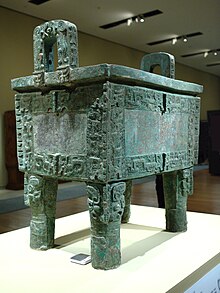
Both archaeological evidence like oracle bones and bronzes, as well as transmitted texts attest the historical existence of the Shang dynasty (c. 1600 – c. 1046 BC). Findings from the earlier Shang period come from excavations at Erligang (modern Zhengzhou). Findings have been found at Yinxu (near modern Anyang, Henan), the site of the final Shang capital during the Late Shang period (c. 1250–1050 BC).[26] The findings at Anyang include the earliest written record of the Chinese so far discovered: inscriptions of divination records in ancient Chinese writing on the bones or shells of animals—the oracle bones, dating from c. 1250 – c. 1046 BC.[27]
A series of at least twenty-nine kings reigned over the Shang dynasty.[28] Throughout their reigns, according to the Shiji, the capital city was moved six times.[29] The final and most important move was to Yin during the reign of Wu Ding c. 1250 BC.[30] The term Yin dynasty has been synonymous with the Shang dynasty in history, although it has lately been used to refer specifically to the latter half of the Shang dynasty.[28]
Although written records found at Anyang confirm the existence of the Shang dynasty,[31] Western scholars are often hesitant to associate settlements that are contemporaneous with the Anyang settlement with the Shang dynasty. For example, archaeological findings at Sanxingdui suggest a technologically advanced civilization culturally unlike Anyang. The evidence is inconclusive in proving how far the Shang realm extended from Anyang. The leading hypothesis is that Anyang, ruled by the same Shang in the official history, coexisted and traded with numerous other culturally diverse settlements in the area that is now referred to as China proper.[32]
Zhou dynasty (1046–256 BC)
The Zhou dynasty (1046 BC to about 256 BC) is the longest-lasting dynasty in Chinese history, though its power declined steadily over the almost eight centuries of its existence. In the late 2nd millennium BC, the Zhou dynasty arose in the Wei River valley of modern western Shaanxi Province, where they were appointed Western Protectors by the Shang. A coalition led by the ruler of the Zhou, King Wu, defeated the Shang at the Battle of Muye. They took over most of the central and lower Yellow River valley and enfeoffed their relatives and allies in semi-independent states across the region.[33] Several of these states eventually became more powerful than the Zhou kings.
The kings of Zhou invoked the concept of the Mandate of Heaven to legitimize their rule, a concept that was influential for almost every succeeding dynasty.[34] Like Shangdi, Heaven (tian) ruled over all the other gods, and it decided who would rule China.[35] It was believed that a ruler lost the Mandate of Heaven when natural disasters occurred in great number, and when, more realistically, the sovereign had apparently lost his concern for the people. In response, the royal house would be overthrown, and a new house would rule, having been granted the Mandate of Heaven.
The Zhou established two capitals Zongzhou (near modern Xi'an) and Chengzhou (Luoyang), with the king's court moving between them regularly. The Zhou alliance gradually expanded eastward into Shandong, southeastward into the Huai River valley, and southward into the Yangtze River valley.[33]
Spring and Autumn period (722–476 BC)
In 771 BC, King You and his forces were defeated in the Battle of Mount Li by rebel states and Quanrong barbarians. The rebel aristocrats established a new ruler, King Ping, in Luoyang,[36]: 4 beginning the second major phase of the Zhou dynasty: the Eastern Zhou period, which is divided into the Spring and Autumn and Warring States periods. The former period is named after the famous Spring and Autumn Annals. The sharply reduced political authority of the royal house left a power vacuum at the center of the Zhou culture sphere. The Zhou kings had delegated local political authority to hundreds of settlement states, some of them only as large as a walled town and surrounding land. These states began to fight against one another and vie for hegemony. The more powerful states tended to conquer and incorporate the weaker ones, so the number of states declined over time.[37] By the 6th century BC most small states had disappeared by being annexed and just a few large and powerful principalities remained. Some southern states, such as Chu and Wu, claimed independence from the Zhou, who undertook wars against some of them (Wu and Yue). Many new cities were established in this period and society gradually became more urbanized and commercialized. Many famous individuals such as Laozi, Confucius and Sun Tzu lived during this chaotic period.
Conflict in this period occurred both between and within states. Warfare between states forced the surviving states to develop better administrations to mobilize more soldiers and resources. Within states there was constant jockeying between elite families. For example, the three most powerful families in the Jin state—Zhao, Wei and Han—eventually overthrew the ruling family and partitioned the state between them.
The Hundred Schools of Thought of classical Chinese philosophy began blossoming during this period and the subsequent Warring States period. Such influential intellectual movements as Confucianism, Taoism, Legalism and Mohism were founded, partly in response to the changing political world. The first two philosophical thoughts would have an enormous influence on Chinese culture.
Warring States period (476–221 BC)
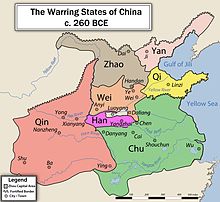
After further political consolidations, seven prominent states remained during the 5th century BC. The years in which these states battled each other is known as the Warring States period. Though the Zhou king nominally remained as such until 256 BC, he was largely a figurehead that held little real power.
Numerous developments were made during this period in the areas of culture and mathematics—including the Zuo Zhuan within the Spring and Autumn Annals (a literary work summarizing the preceding Spring and Autumn period), and the bundle of 21 bamboo slips from the Tsinghua collection, dated to 305 BC—being the world's earliest known example of a two-digit, base-10 multiplication table. The Tsinghua collection indicates that sophisticated commercial arithmetic was already established during this period.[38]
As neighboring territories of the seven states were annexed (including areas of modern Sichuan and Liaoning), they were now to be governed under an administrative system of commanderies and prefectures. This system had been in use elsewhere since the Spring and Autumn period, and its influence on administration would prove resilient—its terminology can still be seen in the contemporaneous sheng and xian ("provinces" and "counties") of contemporary China.
The state of Qin became dominant in the waning decades of the Warring States period, conquering the Shu capital of Jinsha on the Chengdu Plain; and then eventually driving Chu from its place in the Han River valley. Qin imitated the administrative reforms of the other states, thereby becoming a powerhouse.[9] Its final expansion began during the reign of Ying Zheng, ultimately unifying the other six regional powers, and enabling him to proclaim himself as China's first emperor—known to history as Qin Shi Huang.
Imperial China
Early imperial China
Qin dynasty (221–206 BC)
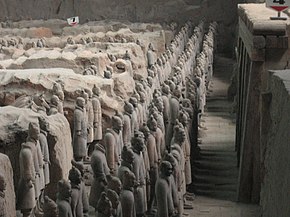
Ying Zheng's establishment of the Qin dynasty (秦朝) in 221 BC effectively formalised the region as a true empire for the first time in Chinese history, rather than a state, and its pivotal status probably led to "Qin" (秦) later evolving into the Western term "China".[39] To emphasise his sole rule, Zheng proclaimed himself Shi Huangdi (始皇帝; "First Emperor"); the Huangdi title, derived from Chinese mythology, became the standard for subsequent rulers.[40][a] Based in Xianyang, the empire was a centralized bureaucratic monarchy, a governing scheme which dominated the future of Imperial China.[42][43] In an effort to improve the Zhou's perceived failures, this system consisted of more than 36 commanderies (郡; jun),[b] made up of counties (县; xian) and progressively smaller divisions, each with a local leader.[46]
Many aspects of society were informed by Legalism, a state ideology promoted by the emperor and his chancellor Li Si that was introduced at an earlier time by Shang Yang.[47] In legal matters this philosophy emphasised mutual responsibility in disputes and severe punishments for crime, while economic practices included the general encouragement of agriculture and repression of trade.[47] Reforms occurred in weights and measures, writing styles (seal script) and metal currency (Ban Liang), all of which were standardized.[48][49] Traditionally, Qin Shi Huang is regarded as ordering a mass burning of books and the live burial of scholars under the guise of Legalism, though contemporary scholars express considerable doubt on the historicity of this event.[47] Despite its importance, Legalism was probably supplemented in non-political matters by Confucianism for social and moral beliefs and the five-element Wuxing (五行) theories for cosmological thought.[50]
The Qin administration kept exhaustive records on their population, collecting information on their sex, age, social status and residence.[51] Commoners, who made up over 90% of the population,[52] "suffered harsh treatment" according to the historian Patricia Buckley Ebrey, as they were often conscripted into forced labor for the empire's construction projects.[53] This included a massive system of imperial highways in 220 BC, which ranged around 4,250 miles (6,840 km) altogether.[54] Other major construction projects were assigned to the general Meng Tian, who concurrently led a successful campaign against the northern Xiongnu peoples (210s BC), reportedly with 300,000 troops.[54][c] Under Qin Shi Huang's orders, Meng supervised the combining of numerous ancient walls into what came to be known as the Great Wall of China and oversaw the building of a 500 miles (800 km) straight highway between northern and southern China.[56] The emperor also oversaw the construction of his monumental mausoleum, which includes the well known Terracotta Army.[57]
After Qin Shi Huang's death the Qin government drastically deteriorated and eventually capitulated in 207 BC after the Qin capital was captured and sacked by rebels, which would ultimately lead to the establishment of the Han Empire.[58][59]
Han dynasty (206 BC – AD 220)
Western Han

The Han dynasty was founded by Liu Bang, who emerged victorious in the Chu–Han Contention that followed the fall of the Qin dynasty. A golden age in Chinese history, the Han dynasty's long period of stability and prosperity consolidated the foundation of China as a unified state under a central imperial bureaucracy, which was to last intermittently for most of the next two millennia. During the Han dynasty, territory of China was extended to most of the China proper and to areas far west. Confucianism was officially elevated to orthodox status and was to shape the subsequent Chinese civilization. Art, culture and science all advanced to unprecedented heights. With the profound and lasting impacts of this period of Chinese history, the dynasty name "Han" had been taken as the name of the Chinese people, now the dominant ethnic group in modern China, and had been commonly used to refer to Chinese language and written characters.
After the initial laissez-faire policies of Emperors Wen and Jing, the ambitious Emperor Wu brought the empire to its zenith. To consolidate his power, he disenfranchised the majority of imperial relatives, appointing military governors to control their former lands.[60] As a further step, he extended patronage to Confucianism, which emphasizes stability and order in a well-structured society. Imperial Universities were established to support its study. At the urging of his Legalist advisors, however, he also strengthened the fiscal structure of the dynasty with government monopolies.
Right image: Reverse side of a Western-Han bronze mirror with painted designs of a flower motif
Major military campaigns were launched to weaken the nomadic Xiongnu Empire, limiting their influence north of the Great Wall. Along with the diplomatic efforts led by Zhang Qian, the sphere of influence of the Han Empire extended to the states in the Tarim Basin, opened up the Silk Road that connected China to the west, stimulating bilateral trade and cultural exchange. To the south, various small kingdoms far beyond the Yangtze River Valley were formally incorporated into the empire.
Emperor Wu also dispatched a series of military campaigns against the Baiyue tribes. The Han annexed Minyue in 135 BC and 111 BC, Nanyue in 111 BC, and Dian in 109 BC.[61] Migration and military expeditions led to the cultural assimilation of the south.[62] It also brought the Han into contact with kingdoms in Southeast Asia, introducing diplomacy and trade.[63]
After Emperor Wu the empire slipped into gradual stagnation and decline. Economically, the state treasury was strained by excessive campaigns and projects, while land acquisitions by elite families gradually drained the tax base. Various consort clans exerted increasing control over strings of incompetent emperors and eventually the dynasty was briefly interrupted by the usurpation of Wang Mang.
Xin dynasty
In AD 9 the usurper Wang Mang claimed that the Mandate of Heaven called for the end of the Han dynasty and the rise of his own, and he founded the short-lived Xin dynasty. Wang Mang started an extensive program of land and other economic reforms, including the outlawing of slavery and land nationalization and redistribution. These programs, however, were never supported by the landholding families, because they favored the peasants. The instability of power brought about chaos, uprisings, and loss of territories. This was compounded by mass flooding of the Yellow River; silt buildup caused it to split into two channels and displaced large numbers of farmers. Wang Mang was eventually killed in Weiyang Palace by an enraged peasant mob in AD 23.
Eastern Han
Emperor Guangwu reinstated the Han dynasty with the support of landholding and merchant families at Luoyang, east of the former capital Xi'an. Thus, this new era is termed the Eastern Han dynasty. With the capable administrations of Emperors Ming and Zhang, former glories of the dynasty were reclaimed, with brilliant military and cultural achievements. The Xiongnu Empire was decisively defeated. The diplomat and general Ban Chao further expanded the conquests across the Pamirs to the shores of the Caspian Sea,[64]: 175 thus reopening the Silk Road, and bringing trade, foreign cultures, along with the arrival of Buddhism. With extensive connections with the west, the first of several Roman embassies to China were recorded in Chinese sources, coming from the sea route in AD 166, and a second one in AD 284.
The Eastern Han dynasty was one of the most prolific eras of science and technology in ancient China, notably the historic invention of papermaking by Cai Lun, and the numerous scientific and mathematical contributions by the famous polymath Zhang Heng.
Six Dynasties
Three Kingdoms (AD 220–280)
By the 2nd century, the empire declined amidst land acquisitions, invasions, and feuding between consort clans and eunuchs. The Yellow Turban Rebellion broke out in AD 184, ushering in an era of warlords. In the ensuing turmoil, three states emerged, trying to gain predominance and reunify the land, giving this historical period its name. The classic historical novel Romance of the Three Kingdoms dramatizes events of this period.
The warlord Cao Cao reunified the north in 208, and in 220 his son accepted the abdication of Emperor Xian of Han, thus initiating the Wei dynasty. Soon, Wei's rivals Shu and Wu proclaimed their independence. This period was characterized by a gradual decentralization of the state that had existed during the Qin and Han dynasties, and an increase in the power of great families.
In 266, the Jin dynasty overthrew the Wei and later unified the country in 280, but this union was short-lived.
Jin dynasty (AD 266–420)
The Jin dynasty reunited China proper for the first time since the end of the Han dynasty, ending the Three Kingdoms era. However, the Jin dynasty was severely weakened by the War of the Eight Princes and lost control of northern China after non-Han Chinese settlers rebelled and captured Luoyang and Chang'an. In 317, the Jin prince Sima Rui, based in modern-day Nanjing, became emperor and continued the dynasty, now known as the Eastern Jin, which held southern China for another century. Prior to this move, historians refer to the Jin dynasty as the Western Jin.
Sixteen Kingdoms (AD 304–439)
Northern China fragmented into a series of independent states known as the Sixteen Kingdoms, most of which were founded by Xiongnu, Xianbei, Jie, Di and Qiang rulers. These non-Han peoples were ancestors of the Turks, Mongols, and Tibetans. Many had, to some extent, been "sinicized" long before their ascent to power. In fact, some of them, notably the Qiang and the Xiongnu, had already been allowed to live in the frontier regions within the Great Wall since late Han times. During this period, warfare ravaged the north and prompted large-scale Han Chinese migration south to the Yangtze River Basin and Delta.
Northern and Southern dynasties (AD 420–589)
In the early 5th century China entered a period known as the Northern and Southern dynasties, in which parallel regimes ruled the northern and southern halves of the country. In the south, the Eastern Jin gave way to the Liu Song, Southern Qi, Liang and finally Chen. Each of these Southern dynasties were led by Han Chinese ruling families and used Jiankang (modern Nanjing) as the capital. They held off attacks from the north and preserved many aspects of Chinese civilization, while northern barbarian regimes began to sinify.
In the north the last of the Sixteen Kingdoms was extinguished in 439 by the Northern Wei, a kingdom founded by the Xianbei, a nomadic people who unified northern China. The Northern Wei eventually split into the Eastern and Western Wei, which then became the Northern Qi and Northern Zhou. These regimes were dominated by Xianbei or Han Chinese who had married into Xianbei families. During this period most Xianbei people adopted Han surnames, eventually leading to complete assimilation into the Han.
Despite the division of the country, Buddhism spread throughout the land. In southern China, fierce debates about whether Buddhism should be allowed were held frequently by the royal court and nobles. By the end of the era, Buddhists and Taoists had become much more tolerant of each other.[65]
Mid-imperial China
Sui dynasty (581–618)
The short-lived Sui dynasty was a pivotal period in Chinese history. Founded by Emperor Wen in 581 in succession of the Northern Zhou, the Sui went on to conquer the Southern Chen in 589 to reunify China, ending three centuries of political division. The Sui pioneered many new institutions, including the government system of Three Departments and Six Ministries, imperial examinations for selecting officials from commoners, while improved on the systems of fubing system of the army conscription and the equal-field system of land distributions. These policies, which were adopted by later dynasties, brought enormous population growth, and amassed excessive wealth to the state. Standardized coinage was enforced throughout the unified empire. Buddhism took root as a prominent religion and was supported officially. Sui China was known for its numerous mega-construction projects. Intended for grains shipment and transporting troops, the Grand Canal was constructed, linking the capitals Daxing (Chang'an) and Luoyang to the wealthy southeast region, and in another route, to the northeast border. The Great Wall was also expanded, while series of military conquests and diplomatic maneuvers further pacified its borders. However, the massive invasions of the Korean Peninsula during the Goguryeo–Sui War failed disastrously, triggering widespread revolts that led to the fall of the dynasty.
Tang dynasty (618–907)
The Tang dynasty was a golden age of Chinese civilization, a prosperous, stable, and creative period with significant developments in culture, art, literature, particularly poetry, and technology. Buddhism became the predominant religion for the common people. Chang'an (modern Xi'an), the national capital, was the largest city in the world during its time.[66]
The first emperor, Emperor Gaozu, came to the throne on 18 June 618, placed there by his son, Li Shimin, who became the second emperor, Taizong, one of the greatest emperors in Chinese history. Combined military conquests and diplomatic maneuvers reduced threats from Central Asian tribes, extended the border, and brought neighboring states into a tributary system. Military victories in the Tarim Basin kept the Silk Road open, connecting Chang'an to Central Asia and areas far to the west. In the south, lucrative maritime trade routes from port cities such as Guangzhou connected with distant countries, and foreign merchants settled in China, encouraging a cosmopolitan culture. The Tang culture and social systems were observed and adapted by neighboring countries, most notably Japan. Internally the Grand Canal linked the political heartland in Chang'an to the agricultural and economic centers in the eastern and southern parts of the empire. Xuanzang, a Chinese Buddhist monk, scholar, traveller, and translator travelled to India on his own and returned with "over six hundred Mahayana and Hinayana texts, seven statues of the Buddha and more than a hundred sarira relics."
The prosperity of the early Tang dynasty was abetted by a centralized bureaucracy. The government was organized as "Three Departments and Six Ministries" to separately draft, review, and implement policies. These departments were run by royal family members and landed aristocrats, but as the dynasty wore on, were joined or replaced by scholar officials selected by imperial examinations, setting patterns for later dynasties.
Under the Tang "equal-field system" all land was owned by the Emperor and granted to each family according to household size. Men granted land were conscripted for military service for a fixed period each year, a military policy known as the fubing system. These policies stimulated a rapid growth in productivity and a significant army without much burden on the state treasury. By the dynasty's midpoint, however, standing armies had replaced conscription, and land was continuously falling into the hands of private owners and religious institutions granted exemptions.
The dynasty continued to flourish under the rule of Empress Wu Zetian, the only official empress regnant in Chinese history, and reached its zenith during the long reign of Emperor Xuanzong, who oversaw an empire that stretched from the Pacific to the Aral Sea with at least 50 million people. There were vibrant artistic and cultural creations, including works of the greatest Chinese poets, Li Bai and Du Fu.
At the zenith of prosperity of the empire, the An Lushan Rebellion from 755 to 763 was a watershed event. War, disease, and economic disruption devastated the population and drastically weakened the central imperial government. Upon suppression of the rebellion, regional military governors, known as jiedushi, gained increasingly autonomous status as the central government lost its ability to control them. With loss of revenue from land tax, the central imperial government came to rely heavily on its salt monopoly. Externally, former submissive states raided the empire and the vast border territories were lost for centuries. Nevertheless, civil society recovered and thrived amidst the weakened imperial bureaucracy.
In late Tang period the empire was worn out by recurring revolts of the regional military governors, while scholar-officials engaged in fierce factional strife and corrupted eunuchs amassed immense power. Catastrophically, the Huang Chao Rebellion, from 874 to 884, devastated the entire empire for a decade. The sack of the southern port Guangzhou in 879 was followed by the massacre of most of its inhabitants, especially the large foreign merchant enclaves.[68][69] By 881, both capitals, Luoyang and Chang'an, fell successively. The reliance on ethnic Han and Turkic warlords in suppressing the rebellion increased their power and influence. Consequently, the fall of the dynasty following Zhu Wen's usurpation led to an era of division.
In 808, 30,000 Shatuo under Zhuye Jinzhong defected from the Tibetans to Tang China and the Tibetans punished them by killing Zhuye Jinzhong as they were chasing them.[70] The Uyghurs also fought against an alliance of Shatuo and Tibetans at Beshbalik.[71] The Shatuo Turks under Zhuye Chixin (Li Guochang) served the Tang dynasty in fighting against their fellow Turkic people in the Uyghur Khaganate. In 839, when the Uyghur khaganate (Huigu) general Jueluowu (掘羅勿) rose against the rule of then-reigning Zhangxin Khan, he elicited the help from Zhuye Chixin by giving Zhuye 300 horses, and together, they defeated Zhangxin Khan, who then committed suicide, precipitating the subsequent collapse of the Uyghur Khaganate. In the next few years, when Uyghur Khaganate remnants tried to raid Tang borders, the Shatuo participated extensively in counterattacking the Uyghur Khaganate with other tribes loyal to Tang.[72] In 843, Zhuye Chixin, under the command of the Han Chinese officer Shi Xiong with Tuyuhun, Tangut and Han Chinese troops, participated in a raid against the Uyghur khaganate that led to the slaughter of Uyghur forces at Shahu mountain.[73]
Five Dynasties and Ten Kingdoms (907–960)
The period of political disunity between the Tang and the Song, known as the Five Dynasties and Ten Kingdoms period, lasted from 907 to 960. During this half-century, China was in all respects a multi-state system. Five regimes, namely, (Later) Liang, Tang, Jin, Han and Zhou, rapidly succeeded one another in control of the traditional Imperial heartland in northern China. Among the regimes, rulers of (Later) Tang, Jin and Han were sinicized Shatuo Turks, which ruled over an ethnic majority of Han Chinese in the north. More stable and smaller regimes of mostly ethnic Han rulers coexisted in south and western China over the period, cumulatively constituted the "Ten Kingdoms".
Amidst political chaos in the north, the strategic Sixteen Prefectures (region along today's Great Wall) were ceded to the emerging Khitan Liao dynasty, which drastically weakened the defense of China proper against northern nomadic empires. To the south, Vietnam gained lasting independence after being a Chinese prefecture for many centuries. With wars dominating in Northern China, there were mass southward migrations of population, which further enhanced the southward shift of cultural and economic centers in China. The era ended with the coup of Later Zhou general Zhao Kuangyin, and the establishment of the Song dynasty in 960, which eventually annihilated the remains of the "Ten Kingdoms" and reunified China.
Late imperial China
Song, Liao, Jin, and Western Xia dynasties (960–1279)
In 960, the Song dynasty was founded by Emperor Taizu, with its capital established in Kaifeng (then known as Bianjing). In 979, the Song dynasty reunified most of China proper, while large swaths of the outer territories were occupied by sinicized nomadic empires. The Khitan Liao dynasty, which lasted from 907 to 1125, ruled over Manchuria, Mongolia, and parts of Northern China. Meanwhile, in what are now the north-western Chinese provinces of Gansu, Shaanxi, and Ningxia, the Tangut tribes founded the Western Xia dynasty from 1032 to 1227.
Aiming to recover the strategic sixteen prefectures lost in the previous dynasty, campaigns were launched against the Liao dynasty in the early Song period, which all ended in failure. Then in 1004, the Liao cavalry swept over the exposed North China Plain and reached the outskirts of Kaifeng, forcing the Song's submission and then agreement to the Chanyuan Treaty, which imposed heavy annual tributes from the Song treasury. The treaty was a significant reversal of Chinese dominance of the traditional tributary system. Yet the annual outflow of Song's silver to the Liao was paid back through the purchase of Chinese goods and products, which expanded the Song economy, and replenished its treasury. This dampened the incentive for the Song to further campaign against the Liao. Meanwhile, this cross-border trade and contact induced further sinicization within the Liao Empire, at the expense of its military might which was derived from its nomadic lifestyle. Similar treaties and social-economical consequences occurred in Song's relations with the Jin dynasty.
Within the Liao Empire the Jurchen tribes revolted against their overlords to establish the Jin dynasty in 1115. In 1125, the devastating Jin cataphract annihilated the Liao dynasty, while remnants of Liao court members fled to Central Asia to found the Qara Khitai Empire (Western Liao dynasty). Jin's invasion of the Song dynasty followed swiftly. In 1127, Kaifeng was sacked, a massive catastrophe known as the Jingkang Incident, ending the Northern Song dynasty. Later the entire north of China was conquered. The survived members of Song court regrouped in the new capital city of Hangzhou, and initiated the Southern Song dynasty, which ruled territories south of the Huai River. In the ensuing years, the territory and population of China were divided between the Song dynasty, the Jin dynasty and the Western Xia dynasty. The era ended with the Mongol conquest, as Western Xia fell in 1227, the Jin dynasty in 1234, and finally the Southern Song dynasty in 1279.
Despite its military weakness, the Song dynasty is widely considered to be the high point of classical Chinese civilization. The Song economy, facilitated by technological advancement, had reached a level of sophistication probably unseen in world history before its time. The population soared to over 100 million and the living standards of common people improved tremendously due to improvements in rice cultivation and the wide availability of coal for production. The capital cities of Kaifeng and subsequently Hangzhou were both the most populous cities in the world for their time, and encouraged vibrant civil societies unmatched by previous Chinese dynasties. Although land trading routes to the far west were blocked by nomadic empires, there was extensive maritime trade with neighbouring states, such as in South-east Asia, which facilitated the use of Song coinage as the de facto currency of exchange. Giant wooden vessels equipped with compasses traveled throughout the China Seas and northern Indian Ocean. The concept of insurance was practised by merchants to hedge the risks of such long-haul maritime shipments. With prosperous economic activities, the historically first use of paper currency emerged in the western city of Chengdu, as a cheaper supplement to the existing copper coins.
The Song dynasty was considered to be the golden age of great advancements in science and technology of China, thanks to innovative scholar-officials such as Su Song (1020–1101) and Shen Kuo (1031–1095). Inventions such as the hydro-mechanical astronomical clock, the first continuous and endless power-transmitting chain, woodblock printing and paper money were all invented during the Song dynasty, further cementing its status.
There was court intrigue between the political reformers and conservatives, led by the chancellors Wang Anshi and Sima Guang, respectively. By the mid-to-late 13th century, the Chinese had adopted the dogma of Neo-Confucian philosophy formulated by Zhu Xi. Enormous literary works were compiled during the Song dynasty, such as the innovative historical narrative Zizhi Tongjian ("Comprehensive Mirror to Aid in Government"). The invention of movable-type printing further facilitated the spread of knowledge. Culture and the arts flourished, with grandiose artworks such as Along the River During the Qingming Festival and Eighteen Songs of a Nomad Flute, along with great Buddhist painters such as the prolific Lin Tinggui.
The Song dynasty was also a period of major innovation in the history of warfare. Gunpowder, while invented in the Tang dynasty, was first put into practical use on the battlefield by the Song army, inspiring a succession of new firearms and siege engines designs. During the Southern Song dynasty, as its survival hinged decisively on guarding the Yangtze and Huai River against the cavalry forces from the north, the first standing navy in China was assembled in 1132, with its admiral's headquarters established at Dinghai. Paddle-wheel warships equipped with trebuchets could launch incendiary bombs made of gunpowder and lime to effect, as recorded in Song's victory over the invading Jin forces at the Battle of Tangdao in the East China Sea, and the Battle of Caishi on the Yangtze River in 1161.
The advances in civilisation during the Song dynasty came to an abrupt end following the devastating Mongol conquest of the North and subsequently other areas of the empire, during which the population sharply dwindled, with a marked contraction in economy. Despite viciously halting Mongol advances for more than three decades, the Southern Song capital Hangzhou fell in 1276, followed by the final annihilation of the Song standing navy at the Battle of Yamen in 1279.
Yuan dynasty (1271–1368)
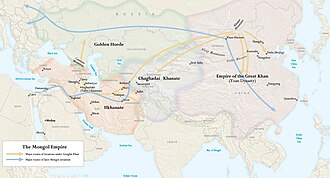
The Yuan dynasty was formally proclaimed in 1271, when the Great Khan of Mongol, Kublai Khan, one of the grandsons of Genghis Khan, assumed the additional title of Emperor of China, and considered his inherited part of the Mongol Empire as a Chinese dynasty. In the preceding decades, the Mongols had conquered the Jin dynasty in Northern China, and the Southern Song dynasty fell in 1279 after a protracted and bloody war. The Mongol Yuan dynasty became the first conquest dynasty in Chinese history to rule the entire China proper and its population as an ethnic minority. The dynasty also directly controlled the Mongol heartland and other regions, inheriting the largest share of territory of the eastern Mongol empire, which roughly coincided with the modern area of China and nearby regions in East Asia. Further expansion of the empire was halted after defeats in the invasions of Japan and Vietnam. Following the previous Jin dynasty, the capital of Yuan dynasty was established at Khanbaliq (also known as Dadu, modern-day Beijing). The Grand Canal was reconstructed to connect the remote capital city to lively economic hubs in southern part of China, setting the precedence and foundation for Beijing to largely remain as the capital of the successive regimes of the unified Chinese mainland.
A series of Mongol civil wars in the late 13th century led to the division of the Mongol Empire. In 1304 the emperors of the Yuan dynasty were upheld as the nominal Khagan over western khanates (the Chagatai Khanate, the Golden Horde and the Ilkhanate), which nonetheless remained de facto autonomous. The era was known as Pax Mongolica, when much of the Asian continent was ruled by the Mongols. For the first and only time in history, the Silk Road was controlled entirely by a single state, facilitating the flow of people, trade, and cultural exchange. A network of roads and a postal system were established to connect the vast empire. Lucrative maritime trade, developed from the previous Song dynasty, continued to flourish, with Quanzhou and Hangzhou emerging as the largest ports in the world. Adventurous travelers from the far west, most notably the Venetian, Marco Polo, would settle in China for decades. Upon his return, his detail travel record inspired generations of medieval Europeans with the splendors of the far East. The Yuan dynasty was the first ancient economy, where paper currency, known at the time as Jiaochao, was used as the predominant medium of exchange. Its unrestricted issuance in the late Yuan dynasty inflicted hyperinflation, which eventually brought the downfall of the dynasty.
While the Mongol rulers of the Yuan dynasty adopted substantially to Chinese culture, their sinicization was of lesser extent compared to earlier conquest dynasties in Chinese history. For preserving racial superiority as the conqueror and ruling class, traditional nomadic customs and heritage from the Mongolian Steppe were held in high regard. On the other hand, the Mongol rulers also adopted flexibly to a variety of cultures from many advanced civilizations within the vast empire. Traditional social structure and culture in China underwent immense transform during the Mongol dominance. Large groups of foreign migrants settled in China, who enjoyed elevated social status over the majority Han Chinese, while enriching Chinese culture with foreign elements. The class of scholar officials and intellectuals, traditional bearers of elite Chinese culture, lost substantial social status. This stimulated the development of culture of the common folks. There were prolific works in zaju variety shows and literary songs (sanqu), which were written in a distinctive poetry style known as qu. Novels of vernacular style gained unprecedented status and popularity.
Before the Mongol invasion, Chinese dynasties reported approximately 120 million inhabitants; after the conquest had been completed in 1279, the 1300 census reported roughly 60 million people.[74] This major decline is not necessarily due only to Mongol killings. Scholars such as Frederick W. Mote argue that the wide drop in numbers reflects an administrative failure to record rather than an actual decrease; others such as Timothy Brook argue that the Mongols created a system of enserfment among a huge portion of the Chinese populace, causing many to disappear from the census altogether; other historians including William McNeill and David Morgan consider that plague was the main factor behind the demographic decline during this period. In the 14th century China suffered additional depredations from epidemics of plague, estimated to have killed around a quarter of the population of China.[75]: 348–351
Throughout the Yuan dynasty, there was some general sentiment among the populace against the Mongol dominance. Yet rather than the nationalist cause, it was mainly strings of natural disasters and incompetent, corrupt governance that triggered widespread peasant uprisings since the 1340s. After the massive naval engagement at Lake Poyang, Zhu Yuanzhang prevailed over other rebel forces in the south. He proclaimed himself emperor and founded the Ming dynasty in 1368. The same year his northern expedition army captured the capital Khanbaliq. The Yuan remnants fled back to Mongolia and sustained the regime, but the period of Yuan dominance was effectively over for good. Other Mongol Khanates in Central Asia continued to exist after the fall of Yuan dynasty in China.
Ming dynasty (1368–1644)
The Ming dynasty was founded by Zhu Yuanzhang in 1368, who proclaimed himself as the Hongwu Emperor. The capital was initially set at Nanjing, and was later moved to Beijing from Yongle Emperor's reign onward.
Urbanization increased as the population grew and as the division of labor grew more complex. Large urban centers, such as Nanjing and Beijing, also contributed to the growth of private industry. In particular, small-scale industries grew up, often specializing in paper, silk, cotton, and porcelain goods. For the most part, however, relatively small urban centers with markets proliferated around the country. Town markets mainly traded food, with some necessary manufactures such as pins or oil.
Despite the xenophobia and intellectual introspection characteristic of the increasingly popular new school of neo-Confucianism, China under the early Ming dynasty was not isolated. Foreign trade and other contacts with the outside world, particularly Japan, increased considerably. Chinese merchants explored all of the Indian Ocean, reaching East Africa with the voyages of Zheng He.
The Hongwu Emperor, being the only founder of a Chinese dynasty who was also of peasant origin, had laid the foundation of a state that relied fundamentally in agriculture. Commerce and trade, which flourished in the previous Song and Yuan dynasties, were less emphasized. Neo-feudal landholdings of the Song and Mongol periods were expropriated by the Ming rulers. Land estates were confiscated by the government, fragmented, and rented out. Private slavery was forbidden. Consequently, after the death of the Yongle Emperor, independent peasant landholders predominated in Chinese agriculture. These laws might have paved the way to removing the worst of the poverty during the previous regimes. Towards later era of the Ming dynasty, with declining government control, commerce, trade and private industries revived.
The dynasty had a strong and complex central government that unified and controlled the empire. The emperor's role became more autocratic, although Hongwu Emperor necessarily continued to use what he called the "Grand Secretariat" to assist with the immense paperwork of the bureaucracy, including memorials (petitions and recommendations to the throne), imperial edicts in reply, reports of various kinds, and tax records. It was this same bureaucracy that later prevented the Ming government from being able to adapt to changes in society, and eventually led to its decline.
The Yongle Emperor strenuously tried to extend China's influence beyond its borders by demanding other rulers send ambassadors to China to present tribute. A large navy was built, including four-masted ships displacing 1,500 tons. A standing army of 1 million troops was created. The Chinese armies conquered and occupied Vietnam for around 20 years, while the Chinese fleet sailed the China seas and the Indian Ocean, cruising as far as the east coast of Africa. The Chinese gained influence in eastern Moghulistan. Several maritime Asian nations sent envoys with tribute for the Chinese emperor. Domestically, the Grand Canal was expanded and became a stimulus to domestic trade. Over 100,000 tons of iron per year were produced. Many books were printed using movable type. The imperial palace in Beijing's Forbidden City reached its current splendor. It was also during these centuries that the potential of south China came to be fully exploited. New crops were widely cultivated and industries such as those producing porcelain and textiles flourished.
In 1449 Esen Tayisi led an Oirat Mongol invasion of northern China which culminated in the capture of the Zhengtong Emperor at Tumu. Since then, the Ming became on the defensive on the northern frontier, which led to the Ming Great Wall being built. Most of what remains of the Great Wall of China today was either built or repaired by the Ming. The brick and granite work was enlarged, the watchtowers were redesigned, and cannons were placed along its length.
At sea the Ming became increasingly isolationist after the death of the Yongle Emperor. The treasure voyages which sailed the Indian Ocean were discontinued, and the maritime prohibition laws were set in place banning the Chinese from sailing abroad. European traders who reached China in the midst of the Age of Discovery were repeatedly rebuked in their requests for trade, with the Portuguese being repulsed by the Ming navy at Tuen Mun in 1521 and again in 1522. Domestic and foreign demands for overseas trade, deemed illegal by the state, led to widespread wokou piracy attacking the southeastern coastline during the rule of the Jiajing Emperor (1507–1567), which only subsided after the opening of ports in Guangdong and Fujian and much military suppression.[76] In addition to raids from Japan by the wokou, raids from Taiwan and the Philippines by the Pisheye also ravaged the southern coasts.[77] The Portuguese were allowed to settle in Macau in 1557 for trade, which remained in Portuguese hands until 1999. After the Spanish invasion of the Philippines, trade with the Spanish at Manila imported large quantities of Mexican and Peruvian silver from the Spanish Americas to China.[78]: 144–145 The Dutch entry into the Chinese seas was also met with fierce resistance, with the Dutch being chased off the Penghu islands in the Sino-Dutch conflicts of 1622–1624 and were forced to settle in Taiwan instead. The Dutch in Taiwan fought with the Ming in the Battle of Liaoluo Bay in 1633 and lost, and eventually surrendered to the Ming loyalist Koxinga in 1662, after the fall of the Ming dynasty.
В 1556 году, во время правления императора Цзяджина , землетрясение в Шэнкси убило около 830 000 человек, что самое смертоносное землетрясение за все время.
Династия Мин глубоко вмешалась в японские вторжения в Корею (1592–1598) , что закончилось выводом всех вторгающихся японских сил в Корее и восстановлением династии Чонена , ее традиционного союзника и притока . Региональная гегемония династии Мин была сохранена в результате своих ресурсов. По совпадению, с контролем Мин в Маньчжурии в упадке, племена Манчу ( Джурчена ) под их вождем Нурхачи оторвались от правления Мин и стали мощным, объединенным государством, которое впоследствии было провозглашено как династия Цин . Он продолжал покорить гораздо более ослабленную Корею в качестве притока , завоеванной Монголии и расширил свою территорию до окраины Великой стены. Самая элитная армия династии Мин состояла в том, чтобы выставить на пасе Шанхай , чтобы охранять последнюю оплот против манча, который ослабил его подавление внутренних крестьян .
Династия Цин (1644–1912)
Династия Цин (1644–1912) была последней имперской династией в Китае. Основанная Маньчжой , это была вторая династия завоеваний, которая управляла всем Китаем , и примерно удвоила территорию, контролируемую Мин. Маньч был ранее известен как Jurchens , проживающие в северо -восточной части территории Мин за пределами Великой стены. Они стали главной угрозой для покойной династии Мин после того, как Нурхачи объединились все джученовые племена и его сын, Хонг Тайджи , объявили основание династии Цин в 1636 году. Династия Цин создала систему восьми баннеров , которая обеспечила базовую структуру Цин военный завоевание. Ли Зиченна Крестьянское восстание захватило Пекин в 1644 году, а император Чонген , последний император Мин, покончил жизнь самоубийством. Маньч сортился с генералом Мин Ву Санги , чтобы захватить Пекин, который стал столицей династии Цин, а затем приступил к покорению остатков Мин на юге . Во время перехода Мин-Цин , когда династия Мин, а затем Южная Мин, появляющаяся династия Цин и несколько других фракций, таких как Династия Шун и династия Си, основанная крестьянскими лидерами восстания, сражались друг против друга, что, наряду с бесчисленными стихийными бедствиями в то время, например, из -за маленького ледникового периода [ 79 ] и эпидемии, такие как великая чума в течение последнего десятилетия династии Мин , [ 80 ] вызвал огромную потерю жизни и значительный вред экономике . В общей сложности эти десятилетия произошли потерь в 25 миллионов жизней, но Цин, казалось, восстановил имперскую власть Китая и открыл еще одно цветение искусства. [ 81 ] Ранние императоры манча объединили традиции внутреннего азиатского правления с конфуцианскими нормами традиционного китайского правительства и считались китайской династией.
Маньч соблюдал «приказ очереди», заставив ханьских китайцев усыновить прическу в очереди манчжу . Чиновники должны были носить одежду в стиле манчжу, Чаншан ( платье -баннерс и Tangzhuang ), но обычным гражданским лицам Хань было разрешено носить традиционную одежду Han . Пансермии не могли осуществлять торговлю или ручной труд; Они должны были ходатайствовать, чтобы быть удаленными из статуса баннера. Их считали аристократией и получали ежегодные пенсии, землю и выделения ткани. Император Кангси заказал создание Словаря Канси , наиболее полного словаря китайских иерогене, который был составлен.
В течение следующих полвека все районы, ранее под руководством династии Мин, были консолидированы под Цин. Завоевания в Центральной Азии в восемнадцатом веке расширили территориальный контроль. Между 1673 и 1681 годами Император Канси подал восстание трех феодаторов , восстание трех генералов в южном Китае, которым было отказано в наследственном правлении крупных достоинств, предоставленных предыдущим императором . В 1683 году Цин организовал амфибийное нападение на южного Тайваня, сбив повстанческое королевство Тунгнинг , которое было основано лоялистом Мин Коксинга (Чжэн Ченггонг) в 1662 году после падения Южного Мин и послужил базой Продолжение сопротивления Мин в южном Китае. Цин победил русских в Албазине , что привело к договору Нерчински .
К концу длительного правления императора Цяньлонга в 1796 году империя Цин была в его зените . Цин управлял более трети населения мира и имел самую большую экономику в мире. По территории это была одна из крупнейших империй за всю историю .


В 19 веке империя была внутренне беспокойной и извне угрожала западными державами. Поражение Британской империей в Первой опиумной войне (1840) привело к договору о Нанкине (1842), в соответствии с которым Гонконг был уступил Великобритании и импорт опиума разрешено (произведенный британскими территориями империи). Использование опиума продолжало расти в Китае, отрицательно влияя на стабильность общества. Последующие военные поражения и неравные договоры с другими западными державами продолжались даже после падения династии Цин.
Внутренне восстание в Тайпинге (1851–1864), христианское религиозное движение, возглавляемое «Небесным царем», Хонг Сюкуан, охватил с юга, чтобы установить Небесное Царство Тайп и контролировало примерно треть Китая в течение более десяти лет. Суд в отчаянии уполномочил китайские чиновники Хань, таких как Цзэн Гуофан, поднять местные армии. После первоначальных поражений Зенг раздавил повстанцев в третьей битве на Нанкинг в 1864 году. [ 82 ] Это была одна из крупнейших войн в 19 веке в вовлечении войск; Была огромная потеря жизни, с погибшим от 20 миллионов человек. [ 83 ] Последовал ряд гражданских родов, в том числе Клановые войны Пангти -Хакка , Восстание Нянь Рунган восстание и Пантай Восстание , [ 84 ] Все восстания были в конечном итоге подавлены, но за огромные затраты и миллионы мертвых, серьезно ослабляя центральную имперскую власть. Китай никогда не перестроил сильную центральную армию, и многие местные чиновники использовали свою военную власть, чтобы эффективно управлять самостоятельно в своих провинциях. [ 82 ]
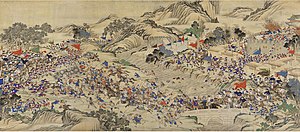
Тем не менее, династия, похоже, выздоровела в восстановлении Тонгжи (1860–1872), во главе с реформаторами королевской семьи Манчу и китайскими чиновниками Хань, такими как Зенг Гоуфан и его протеж Ли Хонгжан и Зуо Зонгтанг . Их самостоятельное движение сделало эффективные институциональные реформы, импортировали западные фабрики и коммуникационные технологии, с главным акцентом на укрепление военных. Однако реформа была подорвана официальным соперничеством, цинизмом и ссорами в имперской семье. Поражение » Юаня Шикая модернизированного « флота в первой китайско-японской войне (1894–1895) привело к формированию новой армии . Император Гуансу , посоветованный Канга Ювей , затем предпринял комплексные усилия по реформе, реформу «Сто дней» (1898). Тем не менее, императрица Cixi опасалась, что ускоренные изменения приведут к бюрократической оппозиции и иностранному вмешательству и быстро его подавило.
Летом 1900 года боксерский восстаний выступил против иностранного влияния и убил китайских христиан и иностранных миссионеров. Когда боксеры вошли в Пекин, правительство Цин приказало всем иностранцам уйти, но они и многие китайские христиане были осаждены в квартале иностранных лиц . Альянс из восьми наций направила экспедицию Сеймура японских, русских, британских, итальянских, немецких, французских, американских и австрийских войск, чтобы освободить осаду, но они были направлены и вынуждены отступить боксерами и войсками Цин в битве при Лангфанге Полем После нападения альянса на форты Дагу , суд объявил войну альянсу и уполномочил боксеров присоединиться к имперским армиям. После жестоких боев в Тяньцзине альянс сформировал вторую, гораздо большую экспедицию газовой газовой , и, наконец, достиг Пекина ; Вдова императрицы эвакуировалась в Сиан . Протокол боксера закончил войну, требовав огромное возмещение .
Затем суд Цин проводил административные и правовые реформы, известные как реформы позднего Цин , включая отмену системы экзаменов . Но молодые чиновники, военные офицеры и студенты обсуждали реформу, возможно, конституционную монархию или свержение династии и создание республики. Они были вдохновлены новым общественным мнением, сформированным интеллектуалами, такими как Лян Цичао , и революционные идеи Sun Yat-Sen . Локализованное военное восстание, восстание Вучанга , началось 10 октября 1911 года в Учане (сегодня часть Ухана ) и вскоре распространился. Китайская Республика была провозглашена 1 января 1912 года, закончив 2000 лет династического правления.
Современный Китай
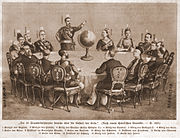
Китайская Республика (с 1912 года)


Временное правительство Китайской Республики было сформировано в Нанкине 12 марта 1912 года. Сунь Ят-Сен стал президентом Китайской Республики , но он передал власть Юаню Шикай , который командовал новой армией . В течение следующих нескольких лет Юань продолжил отменить национальные и провинциальные собрания и объявил себя императором империи Китая в конце 1915 года в стиле абсолютной монархии . Императорские амбиции Юаня были яростно против его подчиненных; Столкнувшись с быстро растущей перспективой насильственного восстания, он отрекся от отрекания в марте 1916 года и умер от естественных причин в июне.
Смерть Юаня в 1916 году оставила вакуум власти; Правительство республиканцев (которое было почти принесено на колени его политикой) было почти разрушено. Это открыло путь для эпохи военачальника , в течение которой большей частью Китая было управляется изменение коалиций конкурирующих провинциальных военных лидеров и правительства Бейяна , вводя в недолговечный период неопределенности. Интеллектуалы, разочарованные неспособностью Республики, начали новое культурное движение .
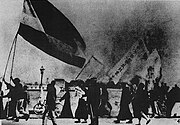
В 1919 году движение четвертого мая началось как ответ на про-японские термины, наложенные на Китай Версальским договором после Первой мировой войны. Оно быстро стало общенациональным протестом. Протесты были моральным успехом, поскольку кабинет министров упал, и Китай отказался подписать Версальский договор, который присудил немецкие активы Шаньдун в Японию. Память о плохом обращении в Версале подпитывает обиду в 21 -м веке. [ 85 ]
Политический и интеллектуальный фермент воскал сильна в течение 1920 -х и 1930 -х годов. По словам Патрисии Эбри:
- "Национализм, патриотизм, прогресс, наука, демократия и свобода были целями; империализм, феодализм, военачальник, самодержавия, патриархат и слепая приверженность традициям были враги. Интеллектуалы боролись с тем, как быть сильным и современным и все же китайцы, как китайские сохранить Китай как политическое сущность в мире конкурирующих наций ». [ 86 ]


В 1920-х годах Sun Yat-Sen создал революционную базу в Гуанчжоу и намеревался объединить фрагментированную нацию. Он приветствовал помощь со стороны Советского Союза (само по себе, только что из коммунистического поглощения Ленина), и он вступил в союз с молодой коммунистической партией Китая (КПК). После смерти Солнца от рака в 1925 году один из его протеже, Чиан Кай-Шек , захватил контроль над националистической партией (КМТ) и преуспел в том, чтобы привлечь большую часть Южного и Центрального Китая под ее правлением в Северной экспедиции (1926–1927). Победив военнослужащих военнослужащих на юге и центральном Китае , Чианг смог обеспечить номинальную верность военачальников на севере и установить националистическое правительство в Нанкине. В 1927 году Чан включил КПК и неустанно очистил элементы коммунистов в своем NRA . В 1934 году, выезжая со своих горных баз, таких как китайская советская Республика , силы КПК вступили в долгой марш по самой пустынной местности Китая на северо -западе, подвиг, превращенный в легенду, где они создали партизанскую базу в Ян'ан в Шэньси. В течение долгого марша коммунисты реорганизовались под новым лидером Мао Цзэдун (Мао Це-Тунг).
Гражданская война в горьком Китае между националистами и коммунистами продолжалась, открыто или тайно, благодаря 14-летней японской оккупации различных частей страны (1931–1945). Две китайские партии номинально сформировали объединенный фронт, чтобы выступить против японцев в 1937 году, во время Второй китайско-японской войны (1937–1945), которая стала частью Второй мировой войны , хотя этот союз в лучшем случае был незначительным и разногласиям, иногда насильственными насильственными , между силами все еще были распространены. Японские силы совершили многочисленные злодеяния военных действий против гражданского населения, включая биологическую войну (см. Блок 731 ) и Три политики Alls ( Sankō Sakusen ), а также: «Убейте всех, сжигайте все и добывают все». [ 87 ] Во время войны Китай был признан одним из « Большой четверки союзников » в Декларации Организацией Объединенных Наций , дань своей устойчивой борьбе против вторгающихся японцев. [ 88 ] Китай был одним из четырех основных союзников Второй мировой войны , а затем считался одним из основных победителей в войне. [ 89 ]
После поражения Японии в 1945 году война между националистическими правительственными войсками и КПК возобновилась после неудачных попыток примирения и урегулирования переговоров. К 1949 году КПК установил контроль над большей частью страны. Странд Арне Вестад говорит, что коммунисты выиграли гражданскую войну, потому что они совершали меньше военных ошибок, чем Чиан, и потому, что в поисках мощного централизованного правительства Чианглизировал слишком много групп интересов в Китае. Кроме того, его партия была ослаблена в войне против японцев. Между тем, коммунисты рассказали различным группам, таким как крестьяне, именно то, что они хотели услышать, и скрылись на обложке китайского национализма. [ 90 ] Во время гражданской войны как националисты, так и коммунисты выполняли массовые злодеяния, миллионы некомбатантов убиты обеими сторонами. [ 91 ] Они включали смерть от принудительного призыва и убийств. [ 92 ]
Теперь, гнилая с внутренней коррупцией и составной тактической ошибкой после ошибки при разрушении лидерства, националисты медленно направлялись на юг. Когда в 1949 году националистические правительственные силы были побеждены силами КПК в материковом Китае, националистическое правительство бежало в Тайвань с его силами, а также Чианг и большое количество их сторонников; Националистическое правительство приняло эффективный контроль над Тайванем в конце Второй мировой войны в рамках общей сдачи японцев, когда японские войска на Тайване сдались там войскам Китая. [ 93 ]
До начала 1970 -х годов ROC был признан единственным законным правительством Китая Организацией Объединенных Наций, Соединенными Штатами и большинством западных наций, отказываясь признать КНР из -за ее статуса коммунистической нации во время холодной войны. Это изменилось в 1971 году, когда КНР сидел в Организации Объединенных Наций , заменив ROC. КМТ управлял Тайванем в рамках военного положения до 1987 года, с заявленной целью быть бдительной против коммунистической инфильтрации и подготовки к возвращению материкового Китая. Следовательно, политическое инакомыслие не терпилось в течение этого периода, и разгонки против диссидентов были обычными.
В 1990 -х годах ROC прошел серьезную демократическую реформу, начиная с отставки 1991 года членов Законодательного Юаня и Национального собрания, избранного в 1947 году. Эти группы были первоначально созданы для представления округов материкового Китая. Также были сняты ограничения на использование тайваньских языков в вещательных СМИ и в школах. Это завершилось первыми прямыми президентскими выборами в 1996 году против кандидата от Демократической прогрессивной партии (DPP) и бывшего диссидента Пенга Мин-Мина . В 2000 году статус KMT как правящей партии закончился, когда DPP принял власть, только для того, чтобы восстановить свой статус на выборах 2008 года Ma Ying-Jeou .
Из -за противоречивого характера политического статуса Тайваня ROC в настоящее время признается просто 12 государствами -членами ООН и Святым Престолом на 2024 год как законное правительство «Китай».
Китайская Народная Республика (с 1949 года)
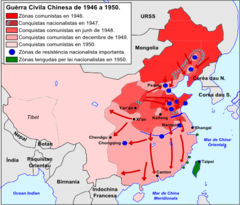
Основной бой в китайской гражданской войне закончился в 1949 году, когда КМТ вырвался с материка, а правительство переехало в Тайбэй и сохранил контроль только на нескольких островах. КПК оставался под контролем материкового Китая . 1 октября 1949 года Мао Цзэдун провозгласил Китайскую Народную Республику. [ 94 ] «Коммунистический Китай» и «Красный Китай» были двумя общими именами для КНР. [ 95 ]
КНР была сформирована серией кампаний и пятилетними планами . Великий прыжок вперед , радикальная кампания, которая охватывала многочисленные попытки экономических и социальных реформ, привела к десяткам миллионов смертей. [ 96 ] [ Лучший источник необходим ] Правительство Мао проводило массовые казнь землевладельцев, организовало коллективизацию и внедрило систему лагеря Лаогай . Казнь, смерть от принудительного труда и других злодеяний привела к миллионам смертей в соответствии с Мао. В 1966 году Мао и его союзники начали культурную революцию , которая продолжалась до смерти Мао десять лет спустя. Культурная революция, мотивированная борьбой за власть в партии и страх перед Советским Союзом , привела к серьезным потрясениям в китайском обществе.
Следуя китайско-советскому расколу и мотивированным проблемами вторжения со стороны Советского Союза или Соединенных Штатов, Китай инициировал кампанию третьего фронта по развитию национальной обороны и промышленной инфраструктуры в своей грубой интерьере. [ 97 ] : 44 Благодаря распределению инфраструктуры, промышленности и человеческого капитала по всей стране, третий фронт создал благоприятные условия для последующего развития рынка и частного предприятия. [ 97 ] : 177
В 1972 году, на пике китайско-советского раскола, Мао и Чжоу Энлай встретились с президентом США Ричардом Никсоном в Пекине, чтобы установить отношения с США. В том же году КНР был принят в Организацию Объединенных Наций вместо Китайской Республики с постоянным членством Совета Безопасности.
Борьба за власть последовала за смертью Мао в 1976 году. Банда из четырех была арестована и обвинена в избытках культурной революции, отмечая конец бурной политической эры в Китае. Денг Сяаопинг пережил помазанного председателя преемника Мао Хуа Гуфенг и постепенно стал де -факто лидером в течение следующих нескольких лет.
Денг Сяаопинг был первостепенным лидером Китая с 1978 по 1992 год, хотя он никогда не стал главой партии или штата, и его влияние в партии привело к значительным экономическим реформам . Впоследствии КПК ослабил государственный контроль над личной жизнью граждан, и коммуны были расформированы, поскольку многие крестьяне получали многочисленные земельные договоры, что значительно увеличило стимулы и сельскохозяйственное производство. Кроме того, было открыто много свободных рыночных площадок. Самой успешной площадью свободного рынка была Шэньчжэнь. Он расположен в Гуандун, и сегодня не существует зона, свободная от налога на недвижимость. Этот поворот событий ознаменовал переход Китая от запланированной экономики к смешанной экономике с все более открытой рынкой, система, называемая некоторыми [ 98 ] как рыночный социализм и официально КПК как социализм с китайскими характеристиками . КНР приняла свою нынешнюю конституцию 4 декабря 1982 года.
В 1989 году смерть бывшего генерального секретаря Ху Яобанга помогла протестировать протесты площади Тяньаньмэнь того года, во время которых студенты и другие проводят кампанию в течение нескольких месяцев, выступая против коррупции и в пользу большей политической реформы, включая демократические права и свободу слова. Полем Тем не менее, они были в конечном итоге положены 4 июня, когда вошли армейские войска и транспортные средства, и насильственно очистили площадь, что привело к значительному количеству погибших . Об этом событии широко сообщалось и принесло во всем мире осуждение и санкции против коммунистического правительства. [ 99 ] [ 100 ]
Генеральный секретарь CCP и президент КНР Цзян Земин и ПРК Премьер Чжу Ронгджи , оба бывшие мэры Шанхая, возглавляли Post-Tiananmen PRC в 1990-х годах. В рамках десятилетней администрации Цзяна и Чжу экономические показатели КНР вытащили около 150 миллионов крестьян из бедности и выдержали среднегодовые темпы роста валового внутреннего продукта в 11,2%. [ 101 ] [ Лучший источник необходим ] Страна официально присоединилась к Всемирной торговой организации в 2001 году. К 1997 и 1999 годам бывшие европейские колонии Британского Гонконга и португальского Макао стали специальными административными регионами Народной Республики Китая Народной Республики.
Хотя КНР нуждался в экономическом росте, чтобы стимулировать его развитие, правительство начало беспокоиться о том, что быстрый экономический рост ухудшает природные ресурсы и окружающую среду страны. Другая проблема заключалась в том, что определенные сектора общества не получали достаточной выгоды от экономического развития КНР; Одним из примеров этого был широкий разрыв между городскими и сельскими районами с точки зрения развития и распространенности обновленной инфраструктуры. В результате при бывшем генеральном секретаре CCP и президенте Ху Цзинтао и премьере Вэнь Цзябао ПРК инициировал политику для решения вопросов справедливого распределения ресурсов, но результат не был известен как в 2014 году. [update]. [ 102 ] Более 40 миллионов фермеров были перемещены с их земли, [ 103 ] Обычно для экономического развития, способствуя 87 000 демонстраций и беспорядков по всему Китаю в 2005 году. [ 104 ] Для большей части населения КНР стандарты жизни улучшились очень существенно, и свобода увеличилась, но политический контроль оставался напряженным, а сельские районы бедны. [ 105 ]
По данным Министерства обороны США 3 миллионов уйгуров и членов других мусульманских , проводятся , в китайских лагерях для интернированных лагерей , которые расположены в регионе Синьцзян групп меньшинств и которые западные новости часто называют «концентрационные лагеря». [ 106 ] Лагеря были созданы в конце 2010 -х годов при Си Цзиньпина администрации . [ 107 ] [ 108 ] Хьюман Райтс Вотч говорит, что они использовались для внушения Uyghurs и других мусульман с 2017 года в рамках Народной войны с террором , объявленной политикой в 2014 году. [ 109 ] [ 110 ] [ 107 ] Использование этих центров, по -видимому, закончилось в 2019 году после международного давления. [ 111 ] Академик Керри Браун связывает их закрытие, начиная с конца 2019 года с расходами, необходимыми для их эксплуатации. [ 112 ] : 138 Китай неоднократно отрицал это, утверждая, что Запад никогда не смог создать надежные спутниковые кадры из каких-либо таких задержанных или в результате задержания групп меньшинств. Несмотря на то, что по состоянию на июнь 2024 года не было проведено никаких комплексных независимых исследований таких центров, спотовые проверки журналистов обнаружили такие участки, преобразованные или заброшенные. [ 111 ] В 2022 году репортер Washington Post проверил дюжину участков, ранее идентифицированных как центры тростников, и обнаружил, что «[M] из них оказались пустыми или преобразованными, с несколькими сайтами, помеченными как карантин коронавирус, школы учителей и профессиональные школы». [ 111 ] В 2023 году Amnesty International заявила, что они «стали свидетелями все более и более произвольного задержания», но задержанные людей переводились из лагерей в официальную тюремную систему . [ 113 ]
Новый коронавирус SARS-COV-2 заболевания , который вызывает COVID-19 , впервые был обнаружен в Ухане , Хубэй в 2019 году и привел к глобальной пандемии , в результате чего большинство мира вступили в период блокировки в течение не менее года. следующий.
-
Народная освободительная армия входит в Пекин в кампании Пингжина
-
Народная Республика Китайская Парад 10 -й годовщины в Пекине
-
Флаг Китайской Народной Республики с 1949 года.
Смотрите также
- Китайские императоры семейное древо
- Китайское исследование
- Китайская историография
- Христианство в Китае
- Экономическая история Китая
- Этнические группы в истории Китая
- Иностранные отношения имперского Китая
- Золотые века Китая
- История каналов в Китае
- История ислама в Китае
- История науки и техники в Китае
- История Тайваня
- История великой китайской стены
- Список китайских монархов
- Список восстаний в Китае
- Список получателей дани из Китая
- Список приточных штатов Китая
- Военная история Китая до 1912 года
- Военно -морская история Китая
- История населения Китая
- Временная шкала китайской истории
- Женщины в древнем и имперском Китае
Ссылки
Примечания
- ^ В своей жизни Инг Чжэн был бы известен как просто Ши Хуанди , но после падения Цинь стало стандартной практикой включить имя династии при упоминании его. В своей полной форме имя Ина будет Цинь Ши Хуанди ( 秦始皇帝 ), хотя это обычно сокращено Цинь Ши Хуанг ( 秦始皇 ). [ 41 ]
- ^ Описание Шиджи командиров Цинь, в том числе 36 , в настоящее время было опровергнуто археологическими данными, указывающими больше. Точное число неизвестно; [ 44 ] Синолог Дерк Бодде отметил, что, вероятно, «четыре и, возможно, до полудюжины были добавлены к 210 к первоначальному тридцать шесть». [ 45 ]
- ^ Другие племена на севере, в совокупности, называемых У Ху Цинь, были свободны от китайского правления во время большинства династии. [ 55 ]
Цитаты
- ^ Jump up to: а беременный в дюймовый Уилкинсон 2018 , с. 737.
- ^ Zhu et al .
- ^ Wu & Lin 1983 , p. 92
- ^ AO et al. 2013 , p. 1
- ^ Джеймс и соавт. 1989 , с. 2
- ^ Jump up to: а беременный Лю и соавт. 2015 , с. 696.
- ^ Hu et al. 2018 , с. 82
- ^ «Неолитический период в Китае» . Временная шкала истории искусства . Метрополитен Музей искусств . Октябрь 2004 г. Получено 10 февраля 2008 года .
- ^ Jump up to: а беременный в Ландер, Брайан (2021). Урожай короля: политическая экология Китая от первых фермеров до первой империи . Издательство Йельского университета.
- ^ Jump up to: а беременный Прингл, Хизер (1998). «Медленное рождение сельского хозяйства» . Наука . 282 (5393): 1446. DOI : 10.1126/Science.282.5393.1446 . ISSN 0036-8075 . S2CID 128522781 . Архивировано из оригинала 1 января 2011 года.
- ^ «Райс и раннее сельское хозяйство в Китае» . Наследие человеческих цивилизаций . Меса Общественный колледж. Архивировано из оригинала 27 августа 2009 года . Получено 10 февраля 2008 года .
- ^ Ринкон, Пол (17 апреля 2003 г.). « Самое раннее письмо» найдено в Китае » . BBC News .
- ^ Qiu Xigui (2000). Китайское письмо . Английский перевод 文字學概論 Гилберта Л. Маттоса и Джерри Нормана . Ранняя Китайская серия монографий № 4. Беркли: Общество изучения раннего Китая и Института исследований Восточной Азии, Калифорнийский университет, Беркли. ISBN 978-1-55729-071-7
- ^ Мо, Дуоуэн; Чжао, Чжидзюн; Сюй, Джуни; Ли, Минглин (2010). «Холоценовые изменения окружающей среды и эволюция неолитических культур в Китае». В Мартини, И. Петр; Чесворт, Уорд (ред.). Ландшафты и общества: выбранные случаи . Спрингер. п. 310. DOI : 10.1007/978-90-481-9413-1_19 . ISBN 978-90-481-9412-4 .
- ^ Хайэм, Чарльз (2004). Энциклопедия древних азиатских цивилизаций . Infobase. п. 200. ISBN 0-8160-4640-9 .
- ^ Шелах, Гидеон (2002). Стратегии лидерства, экономическая деятельность и межрегиональное взаимодействие: социальная сложность в северо -восточном Китае . Спрингер. п. 89. doi : 10.1007/0-306-47164-7_5 . ISBN 978-0-306-47164-3 .
- ^ Багли 1999 , с. 135.
- ^ Роусон, Джессика. «Новые открытия ранних династий» . Времена высшее образование . Получено 3 октября 2013 года .
- ^ Хайэм, Чарльз. 1996. Бронзовый век Юго -Восточной Азии [ страница необходима ]
- ^ Чжан, Шанруо Нин (2016). Конфуцианство в современной китайской политике: действенный отчет об авторитарной политической культуре . Lexington Books. п. 56. ISBN 978-0-7391-8240-6 .
- ^ Голдин, Пол Р. (2015). «Представления регионального разнообразия во время восточной династии Чжоу» . В соснах Юрия ; Пол Р. Голдин; Мартин Керн (ред.). Идеология власти и власти идеологии в раннем Китае . Sinica Leidensia, Vol. 124. Брилл. С. 31–48. doi : 10.1163/9789004299337_003 . ISBN 9789004299337 .
- ^ Pines, Юрий (2005). «Средства отрекания: Zhanguo Egalitarianism и Sovereign's Power». T'oung Pao . 91 (4/5): 243–300. doi : 10.1163/156853205774910098 . JSTOR 4529011 .
- ^ Сюй Хонг (Сюй Хонг) (2021). Самый ранний Китай: рост цивилизации Эрли [ Самый ранний Китай: рост цивилизации Эрлиту на китайском языке. ] ( 978-7-108-07083-8 .
- ^ Китай: пять тысяч лет истории и цивилизации . Городской университет Гонконга Пресс. 2007. с. 25. ISBN 978-962-937-140-1 .
- ^ Багли 1999 , с. 158–159.
- ^ Уилкинсон 2018 , с. 756.
- ^ Болц 1986 , с. 436.
- ^ Jump up to: а беременный Keightley 1999 , p. 232.
- ^ Keightley 1999 , p. 233.
- ^ Боисто, Жиль (2023). «Шаос династии Шан« Девять поколений »и правление Ву Динга: к одноилинейной линии передачи королевской силы». Бюллетень школы восточных и африканских исследований . 86 (2). Издательство Кембриджского университета: 293–315, особенно 299, 303. DOI : 10.1017/S0041977X23000277 . S2CID 260994337 .
- ^ Cheung, Kwong-Yue (1983). «Недавние археологические данные, относящиеся к происхождению китайских иерогене». В Кейтли, Дэвид Н.; Барнард, Ноэль (ред.). Происхождение китайской цивилизации . Перевод Барнарда, Ноэль. Калифорнийский университет. п. 235. ISBN 978-0-520-04229-2 .
- ^ Багли 1999 , с. 158
- ^ Jump up to: а беременный Ли Фэн (2006). Ландшафт и власть в раннем Китае: кризис и падение западного Чжоу 1045–771 до н.э. Издательство Кембриджского университета. doi : 10.1017/cbo9780511489655 . ISBN 9780511489655 .
- ^ Марк, Джошуа Дж. (2012). «Древний Китай» . Всемирная история энциклопедии . Получено 3 мая 2022 года .
- ^ Zhang Jinfan (張晉藩) (2014). Традиция и современный переход китайского права . Springer Science & Business Media. п. 159. ISBN 978-3642232664 .
- ^ Чен Минчжэнь; Пайнс, Юрий (2018). «Где король Пинг? История и историография династии Чжоу на восток». Азия майор . 3. 31 (1). Academica Sinica: 1–27. JSTOR 26571325 .
- ^ Hsu, Cho-Yun (1965). Древний Китай в переходе: анализ социальной мобильности, 722–222 до н.э. Стэнфордские исследования в цивилизациях Восточной Азии. Издательство Стэнфордского университета. LCCN 65013110 . OCLC 1145777819 .
- ^ Цю, Джейн (7 января 2014 г.). «Древние времена, спрятанный в китайских бамбуковых полосках. 2300-летняя матрица-самая старая в мире таблица десятичной умножения» . Природа. doi : 10.1038/nature.2014.14482 . Архивировано с оригинала 22 января 2014 года.
- ^ Жил 1986 , с.
- ^ Жил 1986 , с.
- ^ Уилкинсон 2018 , с. 287
- ^ Ebrey 1999 , p. 60
- ^ Нежный 2019 , с. 15
- ^ Нежный 2019 , с. 16–17.
- ^ Жил 1986 , с.
- ^ Нежный 2019 , с. 15–17.
- ^ Jump up to: а беременный в Жил 1986 , с. 58–59.
- ^ Ebrey 1999 , p. 61.
- ^ Жил 1986 , стр.
- ^ Жил 1986 , с. 75–78.
- ^ Нежный 2019 , с. 17
- ^ Льюис 2007 , с. 102
- ^ Ebrey 1999 , p. 63.
- ^ Jump up to: а беременный Жил 1986 , с.
- ^ Льюис 2007 , с. 129
- ^ Жил 1986 , с. 60–61.
- ^ Жил 1986 , с. 82–83.
- ^ Жил 1986 , с.
- ^ Нежный 2019 , с. 22–24.
- ^ Nylan (2016) , стр. 76–79, 84, 107–108.
- ^ Yu 1986 , pp. 455–458.
- ^ Сюй, Пингфанг (2005). Формирование китайской цивилизации: археологическая перспектива . Издательство Йельского университета. п. 281. ISBN 978-0-300-09382-7 .
- ^ Гернет, Жак (1996). История китайской цивилизации . Издательство Кембриджского университета. С. 126–127 . ISBN 978-0-521-49781-7 .
- ^ Итак, Фрэнсис Х. (蘇其康) (2006). «Путешествия, контакт и контакт: китайское повторное открытие Запада» Monumenta Serica 54 Тейлор и Фрэнсис: 165–1 Doi : 10.1179/ mon.2006.54.1.0 40727536JStor 190841108S2CID
- ^ ). Он Ziquan (Hezquan) Zhang Guola (Zhang Guoan) ( 2013 История Вей, Джин, Северная и Южная Династии -е изд.) ( 1 978-7-01-011139-1 Полем OCLC 872462398 .
- ^ Льюис, Марк Эдвард (2012). Космополитическая империя Китая: династия Тан . История Имперского Китая 3. Belknap Press. ISBN 9780674064010 . [ страница необходима ]
- ^ Ebrey 1999 , p. 127
- ^ Ферран, Габриэль , изд. (1922). Путешествие арабского купца Сулейма в Индию и Китай, написанный в 851 году, за которым следует замечания Абу Зайда Хасана (около 916) (на французском языке). Париж Эйдиции Боссард. п. 76
- ^ "Кайфунг евреи" . Университет Камбрии, Отделение религии и философии. Архивировано из оригинала 28 октября 2008 года.
- ^ Юань, Хонг (14 ноября 2022 года). От хитанов до Jurchens & Mongols: история варваров в треугольных войнах и конфликтах квартета . iuniverse. ISBN 9781663242587 .
- ^ Баумер, Кристоф (18 апреля 2018 г.). История Центральной Азии, набор 4-объема . Блумсбери. ISBN 9781838608682 .
- ^ Zizhi Tongjian , Vol .
- ^
- Zizhi Tongjian , Vol .
- Twitchett, Denis (2000). «Тибет в великой стратегии Тан» . В Гансе Ван де Ван (ред.). Война в истории Китая . Sinica Leidensia, Vol. 47. Брилл. п. 173. doi : 10.1163/9789004482944_006 . ISBN 9789004482944 .
- Дардесс, Джон У. (2010). Управляющий Китай: 150–1850 . Хакетт. п. 32. ISBN 9781603844475 .
- ^ Хо, Пинг-Ти (1970). «Оценка общей численности численности фарфора Сун-Хин». Этудес песня . 1 (1): 33–53.
- ^ Суссман, Джордж Д. (2011). "Была ли черная смерть в Индии и Китае?" Полем Бюллетень истории медицины . 85 (3). Издательство Университета Джона Хопкинса: 319–355. doi : 10.1353/bhm.2011.0054 . JSTOR 44452010 . PMID 22080795 . S2CID 41772477 .
- ^ Хакер, Чарльз О. (2007). «Китай> История> Династия Мин> Политическая история> Династическая преемственность» . Encyclopædia Britannica Online .
- ^ Isorena, Efren B. (2004). «Висайские рейдеры Китайского побережья, 1174–1190 гг. Филиппинский квартал культуры и общества . 32 (2): 73–95. JSTOR 29792550 .
Chau Ju-Kua, пишущий в тринадцатом веке, вероятно, был первым, кто упомянул, что некоторые свирепые рейдеры китайского побережья Фукиен , вероятно, пришли в южную часть острова Формоза , он назвал их пи-шо-Ye Полем
- ^ Schottenhammer, Angela (2019). "Соединение Китая с тихоокеанским миром?" Полем Ориентации . 31 Госсенберг: Восточная Азия: 111–171. ISSN 0936-4099 .
- ^ Фан, Ка-вай (март 2023 г.). «Маленький ледниковый период и падение династии Мин: обзор» . Климат . 11 (3). 71. Bibcode : 2023clim ... 11 ... 71f . doi : 10.3390/cli11030071 . Получено 3 сентября 2023 года .

- ^ Ch'iu Chung-Lin (Цю Чжунлин) (июнь 2004 г.). Адаптация чумы и имперская медицинская система Пекина в династии Мин [Эпидемии в Мин Пекине и ответы от системы общественного здравоохранения империи] (PDF) . Коллекция научно -исследовательского института языка истории Центральной академии наук [ Журнал Института истории и филологии, Academica Sinica ] (на китайском языке). 75 (2): 331–388.
- ^ Робертс, Джон Моррис (1997). Короткая история мира . Издательство Оксфордского университета. п. 272. ISBN 0-19-511504-X Полем Архивировано из оригинала 25 ноября 2022 года.
- ^ Jump up to: а беременный Кун, Филипп (1970). Восстание и его враги в позднем Имперском Китае: милитаризация и социальная структура, 1796–1864 . Гарвардская восточная азиатская серия. Тол. 49. Гарвардский университет издательство. Глава 6. ISBN 9780674749511 .
- ^ Белый, Мэтью. «Статистика войн, угнетений и злодеяний девятнадцатого века» . Получено 11 апреля 2007 года .
- ^ Харпер, Дамсан; Фаллон, Стив; Гаскелл, Катя; Грундвиг, Джули; Хеллер, Кэролин; Хухти, Томас; Мейнев, Брэдли; Питтс, Кристофер (2005). Одинокая планета Китай (9 изд.). Одинокая планета. ISBN 1-74059-687-0 .
- ^ Foot, Rosemary (2019). «Вспоминая прошлое, чтобы обеспечить настоящее: Версальское наследие в возрождающемся Китае». Международные дела . 95 (1): 143–160. doi : 10.1093/ia/iiy211 .
- ^ Ebrey 1999 , p. 271.
- ^ Фэрбенк, Джон Кинг ; Goldman, Merle (2006). Китай: новая история (2 -е изд.). Гарвардский университет издательство . п. 320. ISBN 978-0674018280 .
- ^
- «Московская декларация об общей безопасности» . Ежегодник Организации Объединенных Наций 1946–1947 гг . Озеро Успех, Нью -Йорк: Организация Объединенных Наций. 1947. с. 3. OCLC 243471225 . Получено 25 апреля 2015 года .
- «Объявление 1942 года Организацией Объединенных Наций» . Объединенные Нации . Получено 20 июня 2015 года .
- ^
- Хупс, Таунсенд; Бринкли, Дуглас (1997). FDR и создание ООН . Издательство Йельского университета.
- Гаддис, Джон Льюис (1972). Соединенные Штаты и происхождение холодной войны, 1941–1947 . Издательство Колумбийского университета. С. 24–25 . ISBN 978-0-231-12239-9 .
- ^ Westad, Odd Arne (2012). Беспокойная империя: Китай и мир с 1750 года . п. 291.
- ^ Rummel, Rudolph (1994). Смерть правительством .
- ^ Валентино, Бенджамин А. (2005). Окончательные решения: массовое убийство и геноцид в двадцатом веке . Издательство Корнелльского университета . п. 88
- ^ «Ордес Ордера Имперского общего штаб -квартиры Японии» . 2 сентября 1945 г. , «(а) старшие японские командиры и все земли, море, воздух и вспомогательные силы в Китае (исключая Маньчжурию), Формоза и Франции Индокитай к северу от 16 градусов Северной широты должны сдаться генерализимо Чианг-Кай-Шек . "
- ^ Китайцы встали . Центр Калифорнийского университета в области исследований Восточной Азии. Получено 16 апреля 2006 года. Архивировано 6 сентября 2015 года на машине Wayback
- ^ Смит, Джозеф; Дэвис, Саймон (2005). А до z холодной войны . Руководства от А -Z. Тол. Исторические словарры войны, революции и гражданских беспорядков. Том 8 №. 28. Пресс чучела . ISBN 978-0-8108-5384-3 .
- ^ Акбар, Арифа (17 сентября 2010 года). «Большой прыжок Мао убил 45 миллионов за четыре года » . Независимый . Лондон Получено 30 октября 2010 года .
- ^ Jump up to: а беременный Маркиз, Кристофер ; Цяо, Кунюан (2022). Мао и рынки: коммунистические корни китайского предприятия . Нью -Хейвен: издательство Йельского университета . doi : 10.2307/j.ctv3006z6k . ISBN 978-0-300-26883-6 Полем JSTOR J.CTV3006Z6K . OCLC 1348572572 . S2CID 253067190 .
- ^ Харт-Ландсберг, Мартин; Буркетт, Пол (2010). Китай и социализм: рыночные реформы и классовая борьба . Ежемесячная обзорная пресса. ISBN 978-1-58367-123-8 Полем Получено 30 октября 2008 года .
- ^ Янг, Р. (2002). Европейский союз и продвижение демократии . Издательство Оксфордского университета . ISBN 978-0-19-924979-4 . .
- ^ Кэрролл, JM (2007). Краткая история Гонконга . Роуман и Литтлфилд . ISBN 978-0-7425-3422-3 . .
- ^ «Средний экономический рост Китая в 90 -х годах занял 1 -е место в мире» . Люди ежедневно . 1 марта 2000 года.
- ^ «Китай обеспокоен темпами роста» . Би -би -си . Получено 16 апреля 2006 года .
- ^ «Китай: мигранты, студенты, Тайвань» . Миграционные новости . 13 (1). Январь 2006 г.
- ^ «Перед лицом сельских беспорядков Китай раскатывает реформы» . The Washington Post . 28 января 2006 г.
- ^ Томас, Антоний (11 апреля 2006 г.). " Frontline : Tank Man Стенограмма" . Фронт . Пбс . Получено 12 июля 2008 года .
- ^ Чан, Тара Фрэнсис (22 мая 2019 г.). «Поскольку США нацелены на« концентрационные лагеря »Китая, кризис в правах человека Синьцзян только ухудшается» . Newsweek . Beachum, Lateshia (17 ноября 2019 г.). «Угуры и их сторонники осуждают китайские« концентрационные лагеря »,« геноцид »после протекания документов Синьцзяна» . The Washington Post .
- ^ Jump up to: а беременный Рамзи, Остин; Бакли, Крис (16 ноября 2019 г.). « Абсолютно никакой милости»: просочившиеся файлы раскрывают, как Китай организовал массовые задержания мусульман » . New York Times . ISSN 0362-4331 . Получено 16 ноября 2019 года .
- ^ О'Киф, Кейт; Ферек, Кэти Стехи (14 ноября 2019 г.). «Перестаньте называть Китай Си Цзиньпин« президентом », говорит США . Wall Street Journal .
- ^ «Китай: бесплатное Синьцзян« Политическое образование ». Задержанные» . Хьюман Райтс Вотч. 10 сентября 2017 года . Получено 10 сентября 2017 года .
- ^ «Летние каникулы в мусульманском Гулаге Китая» . Внешняя политика . 28 февраля 2018 года . Получено 28 февраля 2018 года .
- ^ Jump up to: а беременный в «Поскольку репрессия облегчает, китайский Синьцзян сталкивается с длинной дорогой к реабилитации» . The Washington Post . 23 сентября 2022 года . Получено 6 октября 2022 года .
- ^ Браун, Керри (2023). Китай включен: политика мира, где Китай номер один . Лондон: Bloomsbury Academic . ISBN 978-1-350-26724-4 .
- ^ Виллеминс, Алекс (19 сентября 2023 г.). «Событие Уйгура в Нью -Йорке идет вперед, несмотря на предупреждение Пекина» . Радио Свободная Азия . Получено 21 сентября 2023 года .
Источники
- АО, Хонг; Dekkers, Mark J.; Вэй, ци; Цян, Сяоке; Сяо, Гоциао (15 августа 2013 г.). «Новые доказательства раннего присутствия гоминидов в Северном Китае» . Научные отчеты . 3 (2403): 2403. Bibcode : 2013natsr ... 3e2403a . doi : 10.1038/srep02403 . PMC 3744199 . PMID 23948715 .
- Болц, Уильям Г. (февраль 1986 г.). «Раннее китайское письмо, мировая археология». Ранние системы письма . 17 (3): 420–436.
- Эбри, Патриция Бакли (1999). Кембридж иллюстрировал историю Китая . Кембридж: издательство Кембриджского университета . ISBN 978-0521196208 .
- Ху, Юэ; Камня-Тул Технология в юго-западном Китае ». . 565 ( ) 18-0710-1 PMID . Средний плейстоцен 82–85 : 7737 . Природа 30455423. . S2CID 53873016 Левалоа
- Джеймс, Стивен Р.; Деннелл, RW; Гилберт, Аллан С.; Льюис, Генри Т.; Говлетт, Джадж; Линч, Томас Ф.; McGrew, WC; Петерс, Чарльз Р.; Папа, Джеффри Дж.; Шталь, Энн Б. (февраль 1989 г.). «Использование огня в нижнем и среднем плейстоцене: обзор доказательств [и комментариев и ответов]». Текущая антропология . 30 (1): 1–26. doi : 10.1086/203705 . JSTOR 2743299 . S2CID 146473957 .
- Льюис, Марк Эдвард (2007). Ранние китайские империи: Цинь и Хан . Кембридж: издательство Гарвардского университета. ISBN 978-0-674-02477-9 .
- Лю, У; Мартинон-Торрес, Мария; Cai, Yan-Jun; Син, песня; Тонг, Хао-Вэнь; Пей, Шу-Вэнь; Серь, Марк Ян; Ву, Сяо-Хонг; Эдвардс, Р. Лоуренс; Ченг, у тебя есть; Ли, Иуань; Ян, Xiong-Xin; Де Кастро, Хосе Мария Бермудес; Wu, Xiu-Jie (2015). «Самый ранний однозначный после современных людей на юге Китая» (PDF) . Природа . 526 (7575): 696–699. Bibcode : 2015ntur.526..696L . Doi : 10.1038/nature15696 . PMID 26466566 . S2CID 205246146 .
- Нилан, Майкл (2016). «Время картирования в таблицах Шиджи и Ханшу » . Восточноазиатская наука, технология и медицина . 43 (1). Брилл: 61–122. doi : 10.1163/26669323-04301004 . JSTOR 90006244 . S2CID 171943719 .
- Уилкинсон, Эндимион (2018). Китайская история: новое руководство (5 -е изд.). Кембридж: Центр Азии Гарвардского университета . ISBN 978-0-9988883-0-9 .
- Ву, Руканг; Лин, Шенглонг (июнь 1983 г.). "Пекин". Scientific American . 248 (6): 92–93. Bibcode : 1983sciam.248f..86r . doi : 10.1038/Scientificamerican0683-86 . JSTOR 24968922 .
- Xiong, Виктор Кунруй; Хаммонд, Кеннет Дж. (2019). Рутледжский справочник Имперской истории Китая . Лондон: Routledge . ISBN 978-0-367-58051-3 .
- Санфт, Чарльз. «Династия Цинь (221–206 гг. До н.э.)». В Xiong & Hammond (2019) , стр. 12–24.
- Чжу, RX; Поттс, Р.; Pan, yx; Yao, ht; Lü, LQ; Чжао, х.; Гао, х.; Чен, LW; Гао, Ф.; Дэн, Кл (декабрь 2008 г.). «Ранние доказательства рода Homo в Восточной Азии». Журнал человеческой эволюции . 55 (6): 1075–1085. doi : 10.1016/j.jhevol.2008.08.005 . PMID 18842287 .
- Фэрбенк, Джон К . ; Twitchett, Denis , eds. (1978–2020). Кембриджская история Китая . Кембридж: издательство Кембриджского университета .
- Бэгли, Роберт (1999). «Шан -археология». В Лоу, Майкл ; Шонесси, Эдвард Л. (ред.). Кембриджская история древнего Китая: от происхождения цивилизации до 221 г. до н.э. Кембридж: издательство Кембриджского университета . ISBN 978-0-521-47030-8 .
- Кейтли, Дэвид Н. (1999). «Шан: первая историческая династия Китая». В Лоу, Майкл ; Шонесси, Эдвард Л. (ред.). Кембриджская история древнего Китая: от происхождения цивилизации до 221 г. до н.э. Кембридж: издательство Кембриджского университета . ISBN 978-0-521-47030-8 .
- Бодде, Дерк (1986). «Государство и империя Чин». В Твитчетте, Деннис ; Лоу, Майкл (ред.). Кембриджская история Китая, том 1: Империи Чин и Хан, 221 до н.э. - АД 220 . Кембридж: издательство Кембриджского университета . ISBN 978-0-521-24327-8 .
- Yu, Ying-Shih (1986). «Иностранные отношения Хана». В Твитчетте, Деннис ; Лоу, Майкл (ред.). Кембриджская история Китая, том 1: Империи Чин и Хан, 221 до н.э. - АД 220 . Кембридж: издательство Кембриджского университета . ISBN 978-0-521-24327-8 .
Дальнейшее чтение
- Дардесс, Джон У. (2010). Управление Китаем, 150–1850 . Hackett Publishing. ISBN 978-1-60384-311-9 .
- Фэрбенк, Джон Кинг и Голдман, Мерл. Китай: новая история. 2 -е изд. (Гарвард, 2006). 640 стр.
- Гернет, Жак. История китайской цивилизации (1996). Один объем обследования.
- Ли, Сяобинг, изд. Китай на войне: энциклопедия . (ABC-Clio, 2012).
- Моте, Фредерик У. Имперский Китай, 900–1800 (Гарвард, 1999), 1136 с. Авторитетное обращение с песней, Юань, Мин и ранние династии Цин.
- Перкинс, Дороти. Энциклопедия Китая: важная ссылка на Китай, его история и культуру (Факты на файле, 1999). 662 стр.
- Робертс, Jag Аккуратная история Китая (Harvard U. Press, 1999). 341 стр.
- Стэнфорд, Эдвард. Атлас китайской империи, содержащий отдельные карты восемнадцати провинций Китая (2 -е изд., 1917). Разборчивые цветные карты.
- Райт, Дэвид Кертис. История Китая (2001) 257 стр.
Внешние ссылки
- Знания Китая , всеобъемлющая онлайн -энциклопедия Китая от Ульриха Теобальда
- Беркширская энциклопедия Китая на Оксфордской ссылке (требуется подписка)
- Китай заново открывает свою собственную историю , длинную лекцию по истории Китая, данная Юй-ши-







